James I.N. Introduction to Circulating Atmospheres
Подождите немного. Документ загружается.

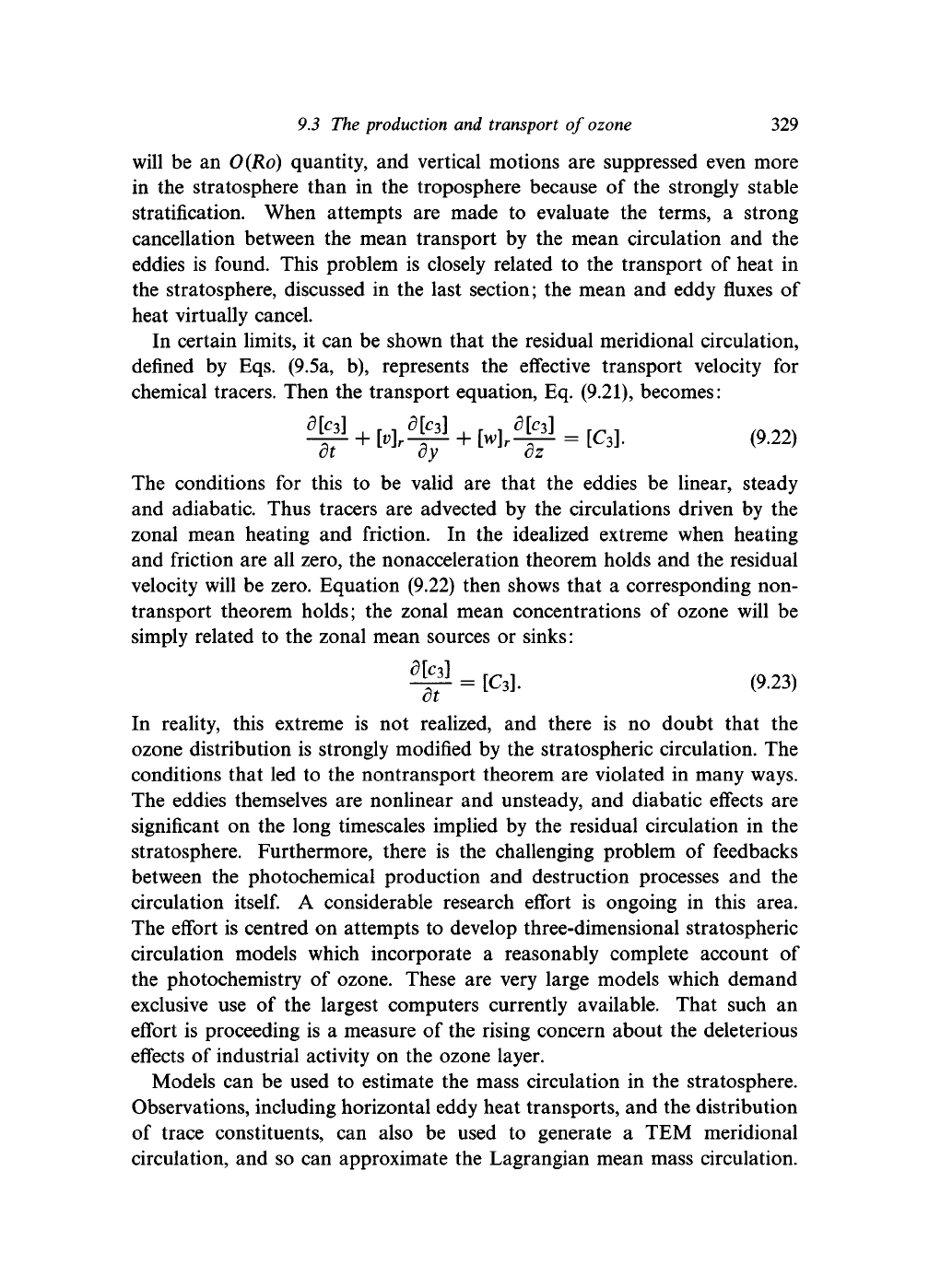
9.3 The production and transport of ozone 329
will be an O(Ro) quantity, and vertical motions are suppressed even more
in the stratosphere than in the troposphere because of the strongly stable
stratification. When attempts are made to evaluate the terms, a strong
cancellation between the mean transport by the mean circulation and the
eddies is found. This problem is closely related to the transport of heat in
the stratosphere, discussed in the last section; the mean and eddy fluxes of
heat virtually cancel.
In certain limits, it can be shown that the residual meridional circulation,
defined by Eqs. (9.5a, b), represents the effective transport velocity for
chemical tracers. Then the transport equation, Eq. (9.21), becomes:
£M
+
Mr
£M
+
M
,£M.,
C3]
.
(
,
22)
The conditions for this to be valid are that the eddies be linear, steady
and adiabatic. Thus tracers are advected by the circulations driven by the
zonal mean heating and friction. In the idealized extreme when heating
and friction are all zero, the nonacceleration theorem holds and the residual
velocity will be zero. Equation (9.22) then shows that a corresponding non-
transport theorem holds; the zonal mean concentrations of ozone will be
simply related to the zonal mean sources or sinks:
= [C
3
]. (9.23)
In reality, this extreme is not realized, and there is no doubt that the
ozone distribution is strongly modified by the stratospheric circulation. The
conditions that led to the nontransport theorem are violated in many ways.
The eddies themselves are nonlinear and unsteady, and diabatic effects are
significant on the long timescales implied by the residual circulation in the
stratosphere. Furthermore, there is the challenging problem of feedbacks
between the photochemical production and destruction processes and the
circulation
itself.
A considerable research effort is ongoing in this area.
The effort is centred on attempts to develop three-dimensional stratospheric
circulation models which incorporate a reasonably complete account of
the photochemistry of ozone. These are very large models which demand
exclusive use of the largest computers currently available. That such an
effort is proceeding is a measure of the rising concern about the deleterious
effects of industrial activity on the ozone layer.
Models can be used to estimate the mass circulation in the stratosphere.
Observations, including horizontal eddy heat transports, and the distribution
of trace constituents, can also be used to generate a TEM meridional
circulation, and so can approximate the Lagrangian mean mass circulation.
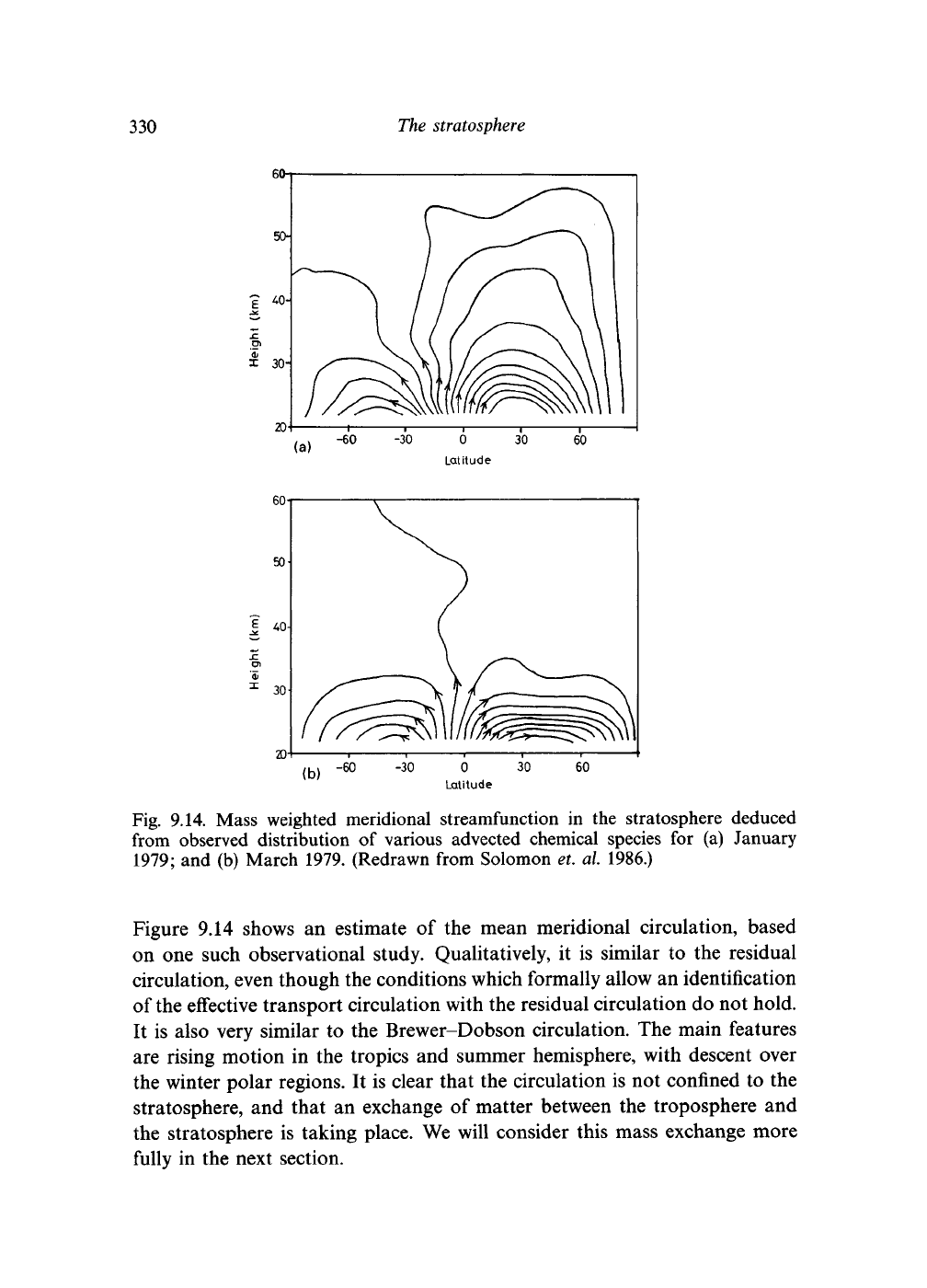
330
The stratosphere
I
A0-
30 60
Latitude
(b)
Fig. 9.14. Mass weighted meridional streamfunction in the stratosphere deduced
from observed distribution of various advected chemical species for (a) January
1979;
and (b) March 1979. (Redrawn from Solomon et. al 1986.)
Figure 9.14 shows an estimate of the mean meridional circulation, based
on one such observational study. Qualitatively, it is similar to the residual
circulation, even though the conditions which formally allow an identification
of
the
effective transport circulation with the residual circulation do not hold.
It is also very similar to the Brewer-Dobson circulation. The main features
are rising motion in the tropics and summer hemisphere, with descent over
the winter polar regions. It is clear that the circulation is not confined to the
stratosphere, and that an exchange of matter between the troposphere and
the stratosphere is taking place. We will consider this mass exchange more
fully in the next section.
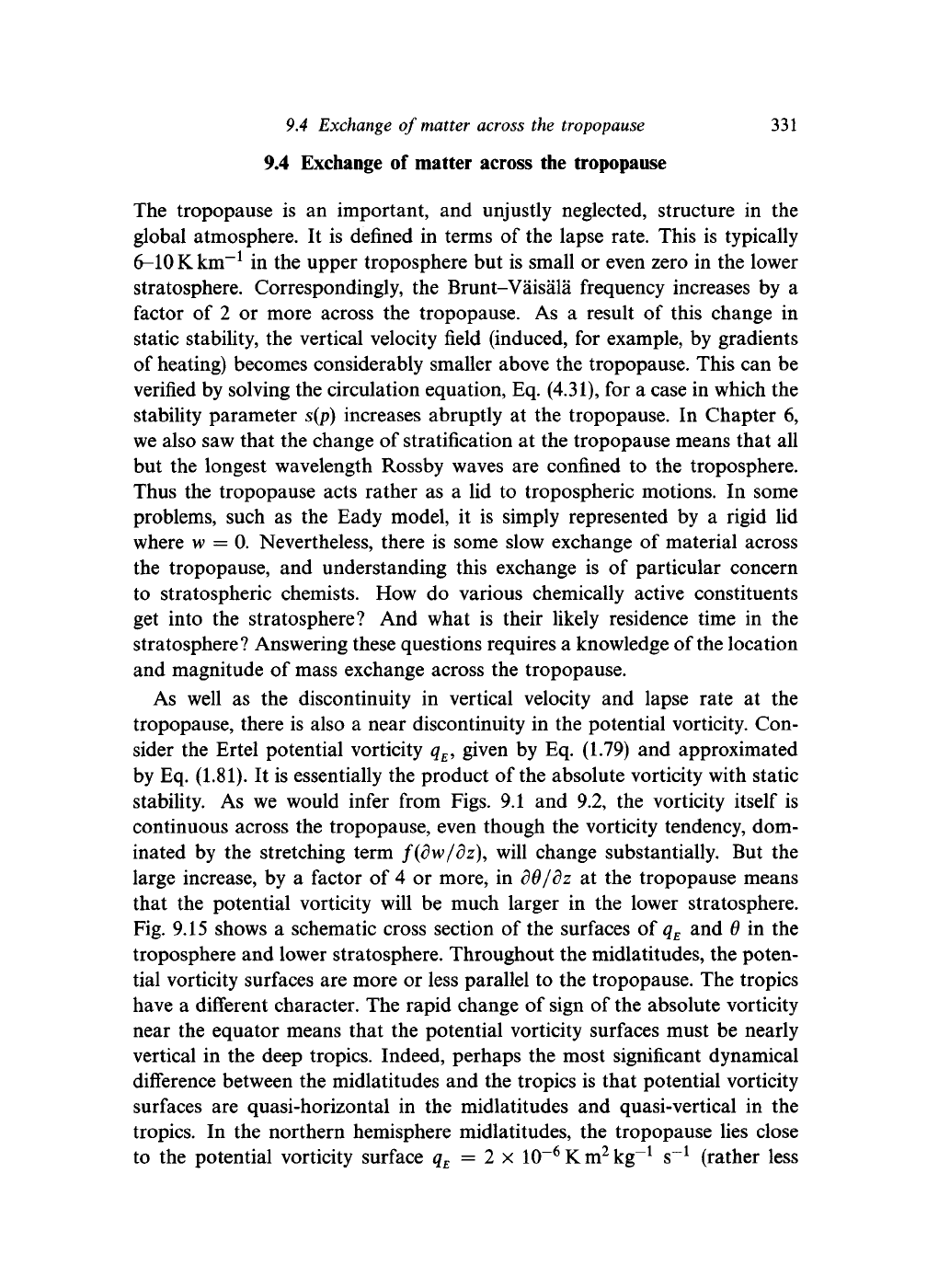
9.4 Exchange of matter across the tropopause 331
9.4 Exchange of matter across the tropopause
The tropopause is an important, and unjustly neglected, structure in the
global atmosphere. It is defined in terms of the lapse rate. This is typically
6-10 K
km"
1
in the upper troposphere but is small or even zero in the lower
stratosphere. Correspondingly, the Brunt-Vaisala frequency increases by a
factor of 2 or more across the tropopause. As a result of this change in
static stability, the vertical velocity field (induced, for example, by gradients
of heating) becomes considerably smaller above the tropopause. This can be
verified by solving the circulation equation, Eq. (4.31), for a case in which the
stability parameter s(p) increases abruptly at the tropopause. In Chapter 6,
we also saw that the change of stratification at the tropopause means that all
but the longest wavelength Rossby waves are confined to the troposphere.
Thus the tropopause acts rather as a lid to tropospheric motions. In some
problems, such as the Eady model, it is simply represented by a rigid lid
where w = 0. Nevertheless, there is some slow exchange of material across
the tropopause, and understanding this exchange is of particular concern
to stratospheric chemists. How do various chemically active constituents
get into the stratosphere? And what is their likely residence time in the
stratosphere? Answering these questions requires a knowledge of the location
and magnitude of mass exchange across the tropopause.
As well as the discontinuity in vertical velocity and lapse rate at the
tropopause, there is also a near discontinuity in the potential vorticity. Con-
sider the Ertel potential vorticity q
E
, given by Eq. (1.79) and approximated
by Eq. (1.81). It is essentially the product of the absolute vorticity with static
stability. As we would infer from Figs. 9.1 and 9.2, the vorticity itself is
continuous across the tropopause, even though the vorticity tendency, dom-
inated by the stretching term f(dw/dz)
9
will change substantially. But the
large increase, by a factor of 4 or more, in dQ/dz at the tropopause means
that the potential vorticity will be much larger in the lower stratosphere.
Fig. 9.15 shows a schematic cross section of the surfaces of
q
E
and 9 in the
troposphere and lower stratosphere. Throughout the midlatitudes, the poten-
tial vorticity surfaces are more or less parallel to the tropopause. The tropics
have a different character. The rapid change of sign of the absolute vorticity
near the equator means that the potential vorticity surfaces must be nearly
vertical in the deep tropics. Indeed, perhaps the most significant dynamical
difference between the midlatitudes and the tropics is that potential vorticity
surfaces are quasi-horizontal in the midlatitudes and quasi-vertical in the
tropics. In the northern hemisphere midlatitudes, the tropopause lies close
to the potential vorticity surface q
E
= 2 x 10~
6
Km
2
kg~
1
s"
1
(rather less
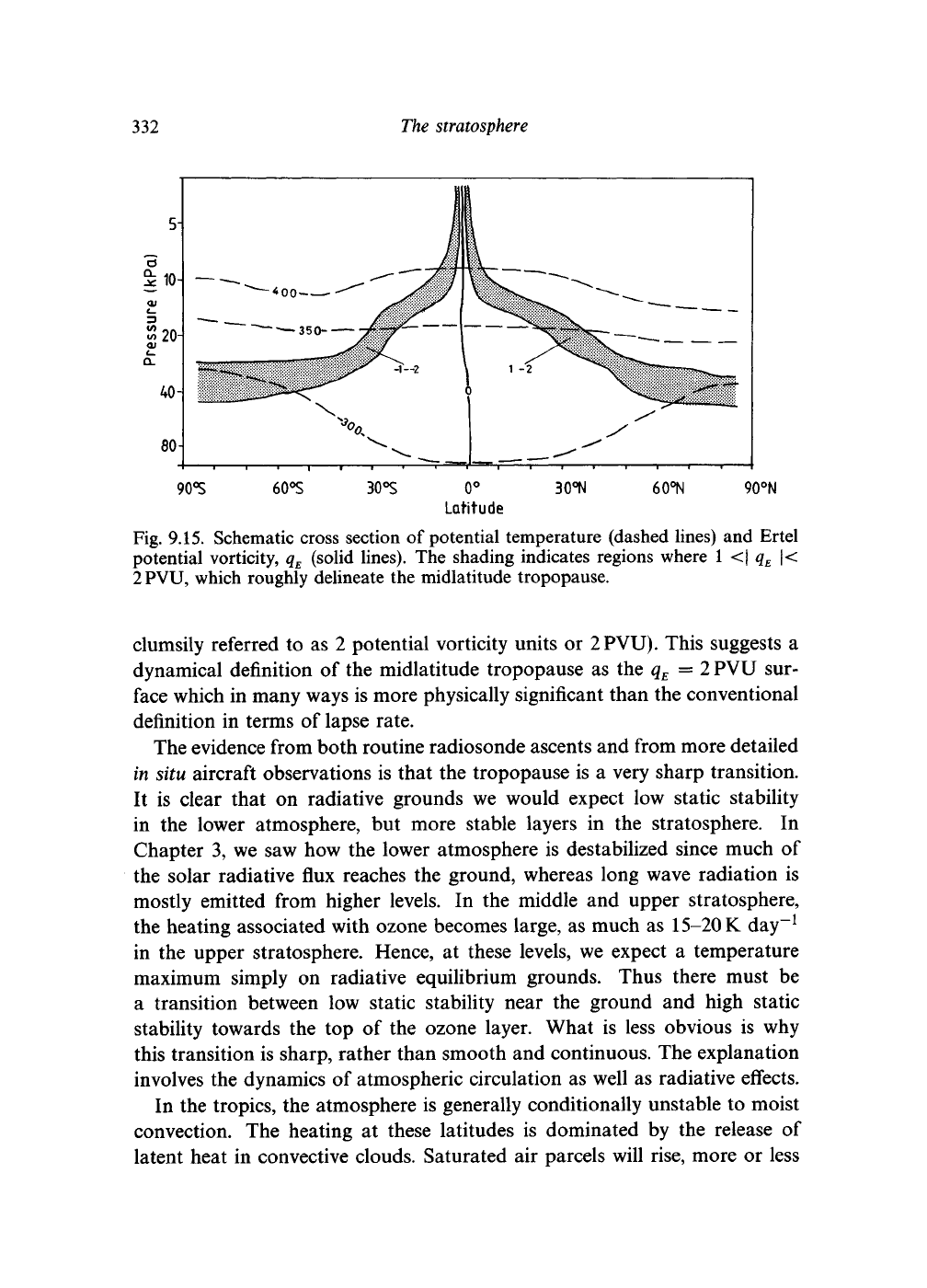
332
The stratosphere
5-
£
10-
|20-
40-
80-
^~-—35 0
1
>^ 1
^\^H
-1—2 \
1
"2 ^\ ^ r^-^^
I
90°S
60°S
30°S
0°
Latitude
30°N
60°N 90°N
Fig. 9.15. Schematic cross section of potential temperature (dashed lines) and Ertel
potential vorticity, q
E
(solid lines). The shading indicates regions where 1 <| q
E
|<
2
PVU,
which roughly delineate the midlatitude tropopause.
clumsily referred to as 2 potential vorticity units or
2
PVU).
This suggests a
dynamical definition of the midlatitude tropopause as the q
E
=
2
PVU sur-
face which in many ways is more physically significant than the conventional
definition in terms of lapse rate.
The evidence from both routine radiosonde ascents and from more detailed
in situ aircraft observations is that the tropopause is a very sharp transition.
It is clear that on radiative grounds we would expect low static stability
in the lower atmosphere, but more stable layers in the stratosphere. In
Chapter 3, we saw how the lower atmosphere is destabilized since much of
the solar radiative flux reaches the ground, whereas long wave radiation is
mostly emitted from higher levels. In the middle and upper stratosphere,
the heating associated with ozone becomes large, as much as 15-20K day"
1
in the upper stratosphere. Hence, at these levels, we expect a temperature
maximum simply on radiative equilibrium grounds. Thus there must be
a transition between low static stability near the ground and high static
stability towards the top of the ozone layer. What is less obvious is why
this transition is sharp, rather than smooth and continuous. The explanation
involves the dynamics of atmospheric circulation as well as radiative effects.
In the tropics, the atmosphere is generally conditionally unstable to moist
convection. The heating at these latitudes is dominated by the release of
latent heat in convective clouds. Saturated air parcels will rise, more or less
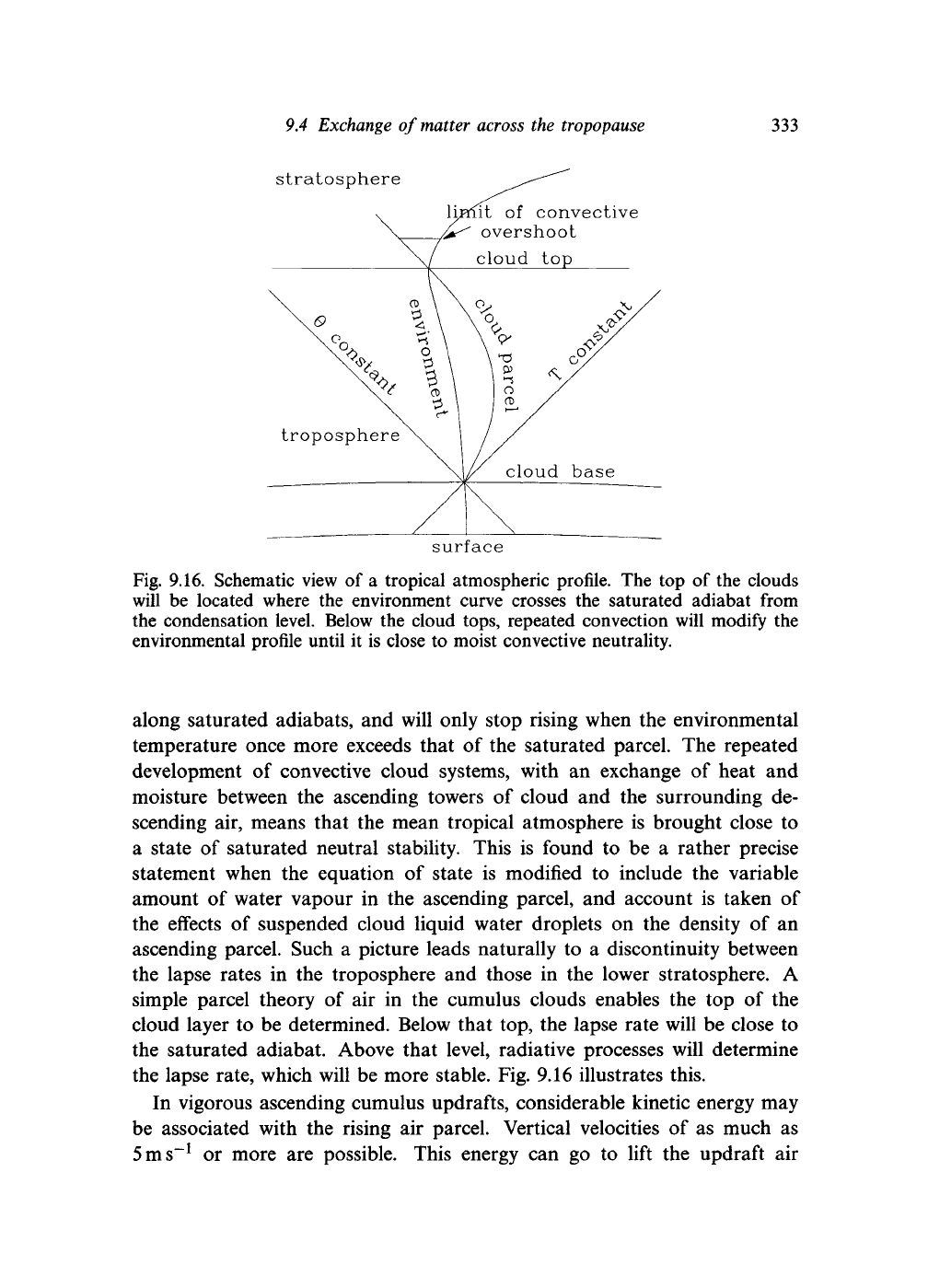
9.4 Exchange
of
matter across the tropopause
333
stratosphere
it of
convective
overshoot
surface
Fig. 9.16. Schematic view
of
a tropical atmospheric profile. The top
of
the clouds
will
be
located where the environment curve crosses the saturated adiabat from
the condensation level. Below the cloud tops, repeated convection will modify the
environmental profile until
it
is close to moist convective neutrality.
along saturated adiabats, and will only stop rising when the environmental
temperature once more exceeds that of the saturated parcel. The repeated
development
of
convective cloud systems, with
an
exchange
of
heat and
moisture between the ascending towers
of
cloud and the surrounding de-
scending air, means that the mean tropical atmosphere is brought close
to
a state of saturated neutral stability. This
is
found
to
be
a
rather precise
statement when the equation
of
state
is
modified
to
include the variable
amount of water vapour in the ascending parcel, and account is taken of
the effects
of
suspended cloud liquid water droplets on the density
of
an
ascending parcel. Such
a
picture leads naturally to
a
discontinuity between
the lapse rates
in
the troposphere and those
in
the lower stratosphere.
A
simple parcel theory
of
air
in
the cumulus clouds enables the top
of
the
cloud layer to be determined. Below that top, the lapse rate will be close to
the saturated adiabat. Above that level, radiative processes will determine
the lapse rate, which will be more stable. Fig. 9.16 illustrates this.
In vigorous ascending cumulus updrafts, considerable kinetic energy may
be associated with the rising air parcel. Vertical velocities
of
as much
as
5
ms"
1
or
more are possible. This energy can go
to
lift the updraft
air
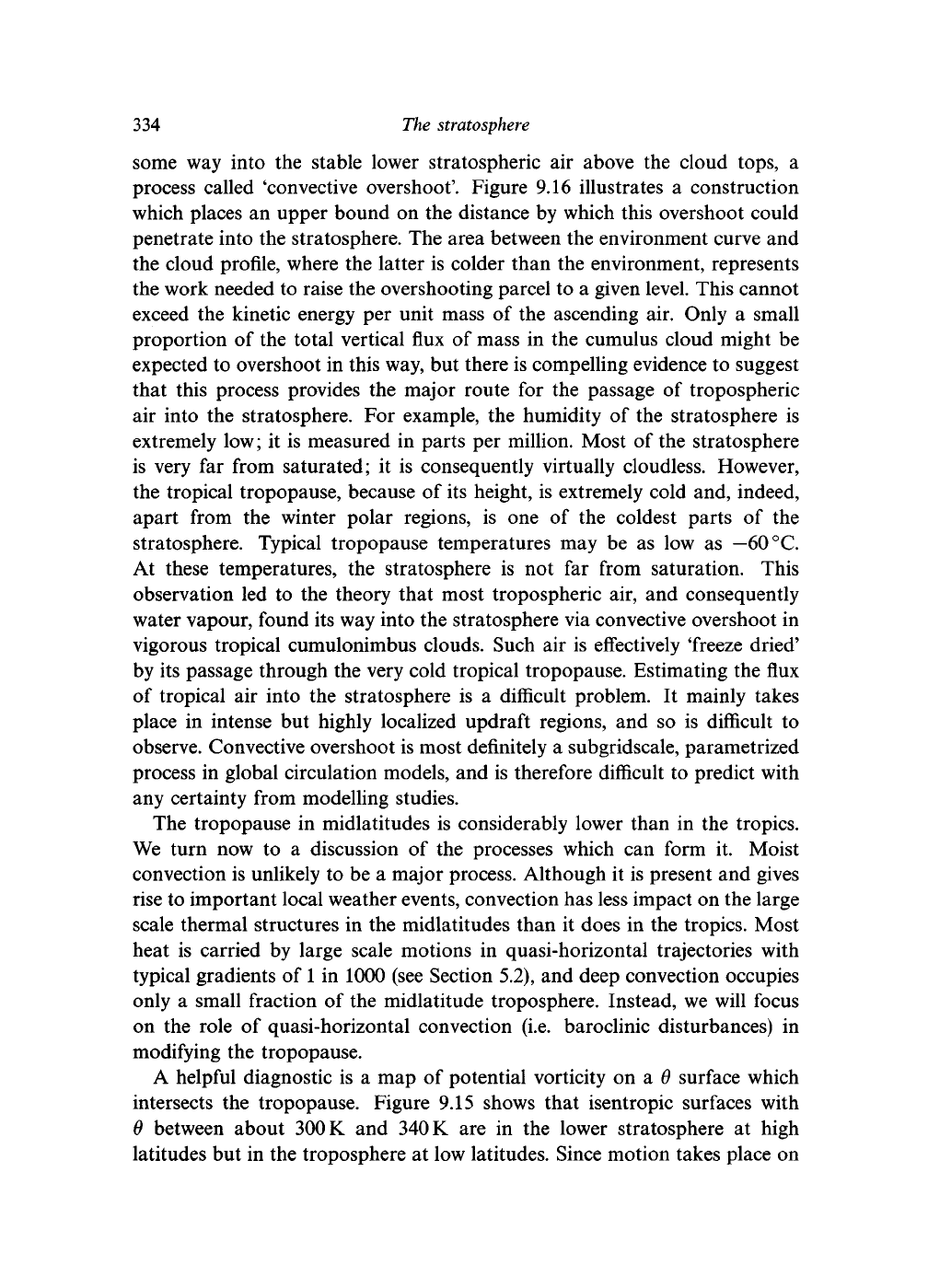
334 The stratosphere
some way into the stable lower stratospheric air above the cloud tops, a
process called 'convective overshoot'. Figure 9.16 illustrates a construction
which places an upper bound on the distance by which this overshoot could
penetrate into the stratosphere. The area between the environment curve and
the cloud profile, where the latter is colder than the environment, represents
the work needed to raise the overshooting parcel to a given level. This cannot
exceed the kinetic energy per unit mass of the ascending air. Only a small
proportion of the total vertical flux of mass in the cumulus cloud might be
expected to overshoot in this way, but there is compelling evidence to suggest
that this process provides the major route for the passage of tropospheric
air into the stratosphere. For example, the humidity of the stratosphere is
extremely low; it is measured in parts per million. Most of the stratosphere
is very far from saturated; it is consequently virtually cloudless. However,
the tropical tropopause, because of its height, is extremely cold and, indeed,
apart from the winter polar regions, is one of the coldest parts of the
stratosphere. Typical tropopause temperatures may be as low as —
60
°C.
At these temperatures, the stratosphere is not far from saturation. This
observation led to the theory that most tropospheric air, and consequently
water vapour, found its way into the stratosphere via convective overshoot in
vigorous tropical cumulonimbus clouds. Such air is effectively 'freeze dried'
by its passage through the very cold tropical tropopause. Estimating the flux
of tropical air into the stratosphere is a difficult problem. It mainly takes
place in intense but highly localized updraft regions, and so is difficult to
observe. Convective overshoot is most definitely a subgridscale, parametrized
process in global circulation models, and is therefore difficult to predict with
any certainty from modelling studies.
The tropopause in midlatitudes is considerably lower than in the tropics.
We turn now to a discussion of the processes which can form it. Moist
convection is unlikely to be a major process. Although it is present and gives
rise to important local weather events, convection has less impact on the large
scale thermal structures in the midlatitudes than it does in the tropics. Most
heat is carried by large scale motions in quasi-horizontal trajectories with
typical gradients of
1
in 1000 (see Section 5.2), and deep convection occupies
only a small fraction of the midlatitude troposphere. Instead, we will focus
on the role of quasi-horizontal convection (i.e. baroclinic disturbances) in
modifying the tropopause.
A helpful diagnostic is a map of potential vorticity on a 6 surface which
intersects the tropopause. Figure 9.15 shows that isentropic surfaces with
9 between about
300
K and
340
K are in the lower stratosphere at high
latitudes but in the troposphere at low latitudes. Since motion takes place on
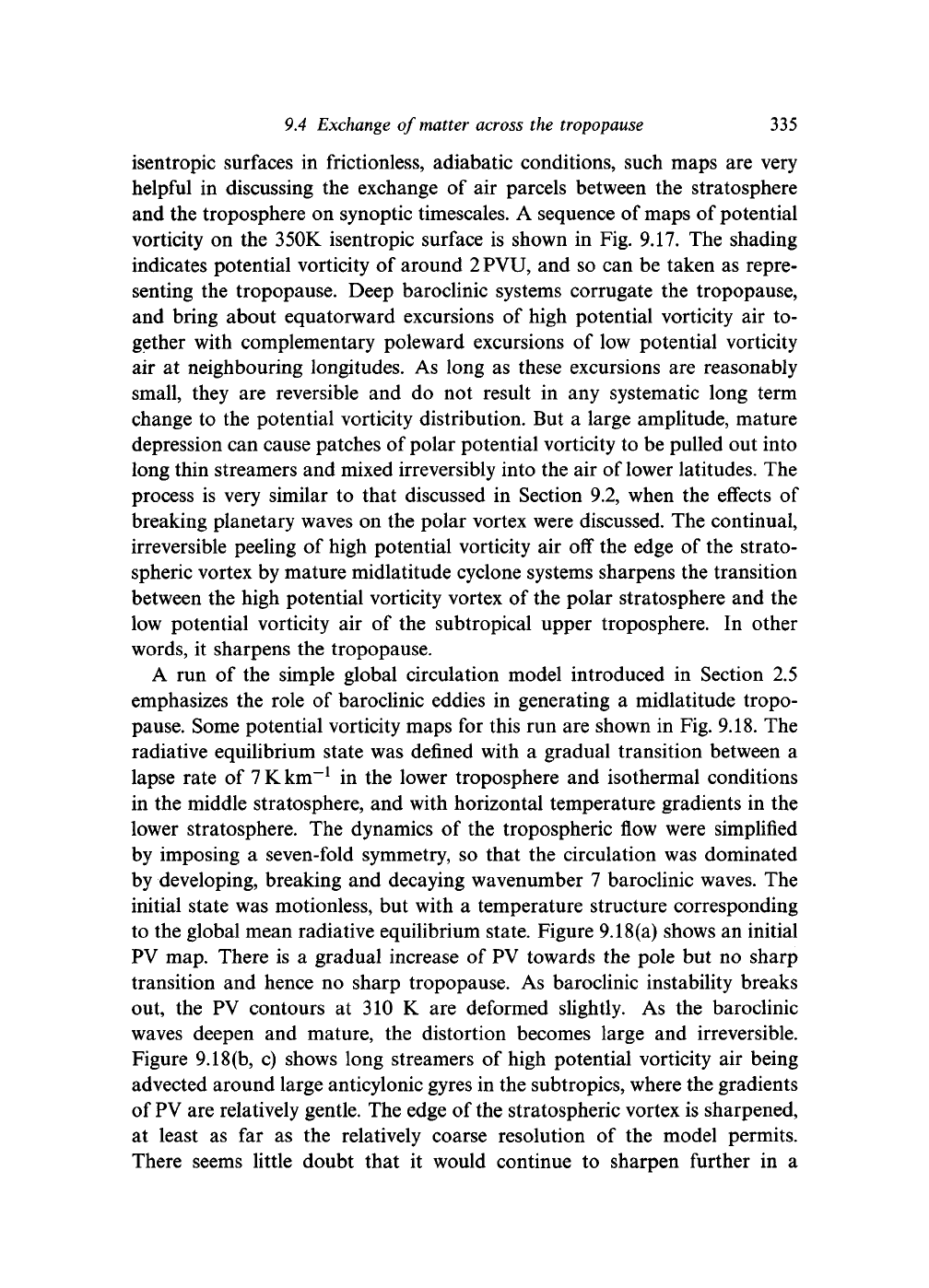
9.4
Exchange
of
matter across
the
tropopause
335
isentropic surfaces in frictionless, adiabatic conditions, such maps are very
helpful in discussing the exchange of air parcels between the stratosphere
and the troposphere on synoptic timescales. A sequence of maps of potential
vorticity on the 35OK isentropic surface is shown in Fig. 9.17. The shading
indicates potential vorticity of around
2
PVU, and so can be taken as repre-
senting the tropopause. Deep baroclinic systems corrugate the tropopause,
and bring about equatorward excursions of high potential vorticity air to-
gether with complementary poleward excursions of low potential vorticity
air at neighbouring longitudes. As long as these excursions are reasonably
small, they are reversible and do not result in any systematic long term
change to the potential vorticity distribution. But a large amplitude, mature
depression can cause patches of polar potential vorticity to be pulled out into
long thin streamers and mixed irreversibly into the air of lower latitudes. The
process is very similar to that discussed in Section 9.2, when the effects of
breaking planetary waves on the polar vortex were discussed. The continual,
irreversible peeling of high potential vorticity air off the edge of the strato-
spheric vortex by mature midlatitude cyclone systems sharpens the transition
between the high potential vorticity vortex of the polar stratosphere and the
low potential vorticity air of the subtropical upper troposphere. In other
words,
it sharpens the tropopause.
A run of the simple global circulation model introduced in Section 2.5
emphasizes the role of baroclinic eddies in generating a midlatitude tropo-
pause. Some potential vorticity maps for this run are shown in Fig. 9.18. The
radiative equilibrium state was defined with a gradual transition between a
lapse rate of
7
K km"
1
in the lower troposphere and isothermal conditions
in the middle stratosphere, and with horizontal temperature gradients in the
lower stratosphere. The dynamics of the tropospheric flow were simplified
by imposing a seven-fold symmetry, so that the circulation was dominated
by developing, breaking and decaying wavenumber 7 baroclinic waves. The
initial state was motionless, but with a temperature structure corresponding
to the global mean radiative equilibrium state. Figure 9.18 (a) shows an initial
PV map. There is a gradual increase of PV towards the pole but no sharp
transition and hence no sharp tropopause. As baroclinic instability breaks
out, the PV contours at 310 K are deformed slightly. As the baroclinic
waves deepen and mature, the distortion becomes large and irreversible.
Figure 9.18(b, c) shows long streamers of high potential vorticity air being
advected around large anticylonic gyres in the subtropics, where the gradients
of PV are relatively gentle. The edge of the stratospheric vortex is sharpened,
at least as far as the relatively coarse resolution of the model permits.
There seems little doubt that it would continue to sharpen further in a
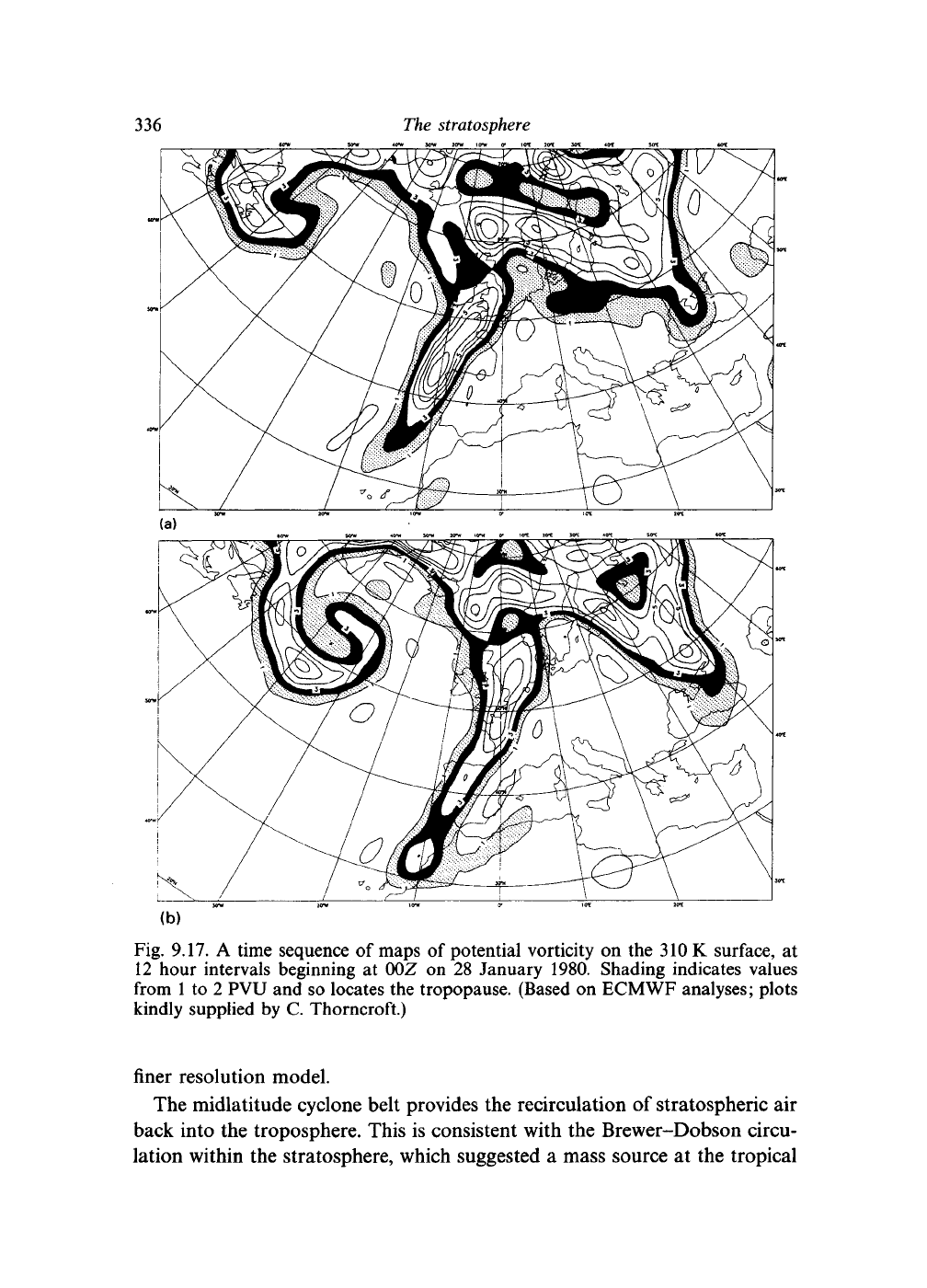
336
The stratosphere
II
\
Fig. 9.17. A time sequence of maps of potential vorticity on the 310 K surface, at
12 hour intervals beginning at 00Z on 28 January 1980. Shading indicates values
from
1
to 2 PVU and so locates the tropopause. (Based on ECMWF analyses; plots
kindly supplied by C. Thorncroft.)
finer resolution model.
The midlatitude cyclone belt provides the recirculation of stratospheric air
back into the troposphere. This is consistent with the Brewer-Dobson circu-
lation within the stratosphere, which suggested a mass source at the tropical
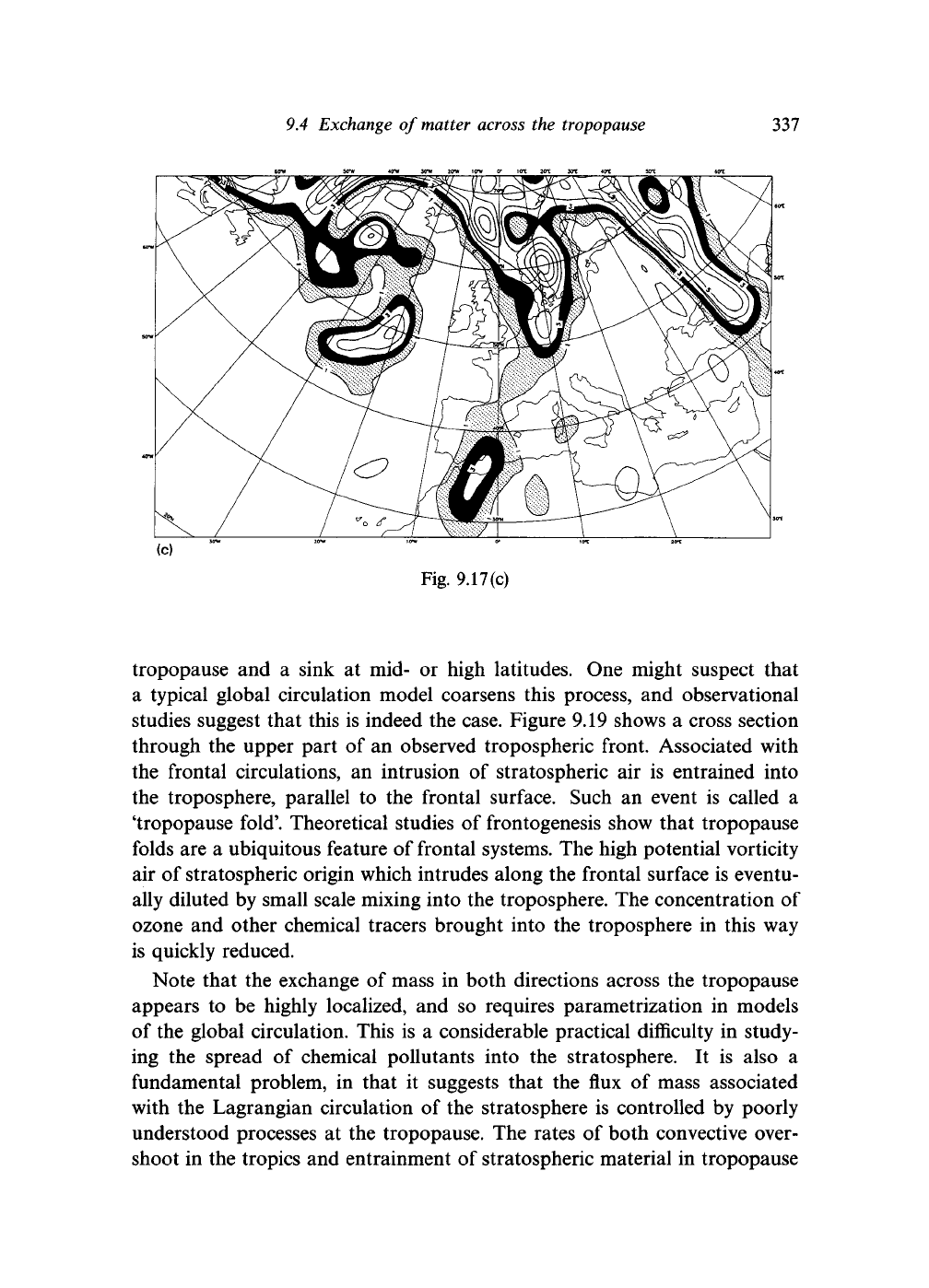
9.4 Exchange of matter across the tropopause
337
Fig. 9.17(c)
tropopause and a sink at mid- or high latitudes. One might suspect that
a typical global circulation model coarsens this process, and observational
studies suggest that this is indeed the case. Figure 9.19 shows a cross section
through the upper part of an observed tropospheric front. Associated with
the frontal circulations, an intrusion of stratospheric air is entrained into
the troposphere, parallel to the frontal surface. Such an event is called a
'tropopause fold'. Theoretical studies of frontogenesis show that tropopause
folds are a ubiquitous feature of frontal systems. The high potential vorticity
air of stratospheric origin which intrudes along the frontal surface is eventu-
ally diluted by small scale mixing into the troposphere. The concentration of
ozone and other chemical tracers brought into the troposphere in this way
is quickly reduced.
Note that the exchange of mass in both directions across the tropopause
appears to be highly localized, and so requires parametrization in models
of the global circulation. This is a considerable practical difficulty in study-
ing the spread of chemical pollutants into the stratosphere. It is also a
fundamental problem, in that it suggests that the flux of mass associated
with the Lagrangian circulation of the stratosphere is controlled by poorly
understood processes at the tropopause. The rates of both convective over-
shoot in the tropics and entrainment of stratospheric material in tropopause
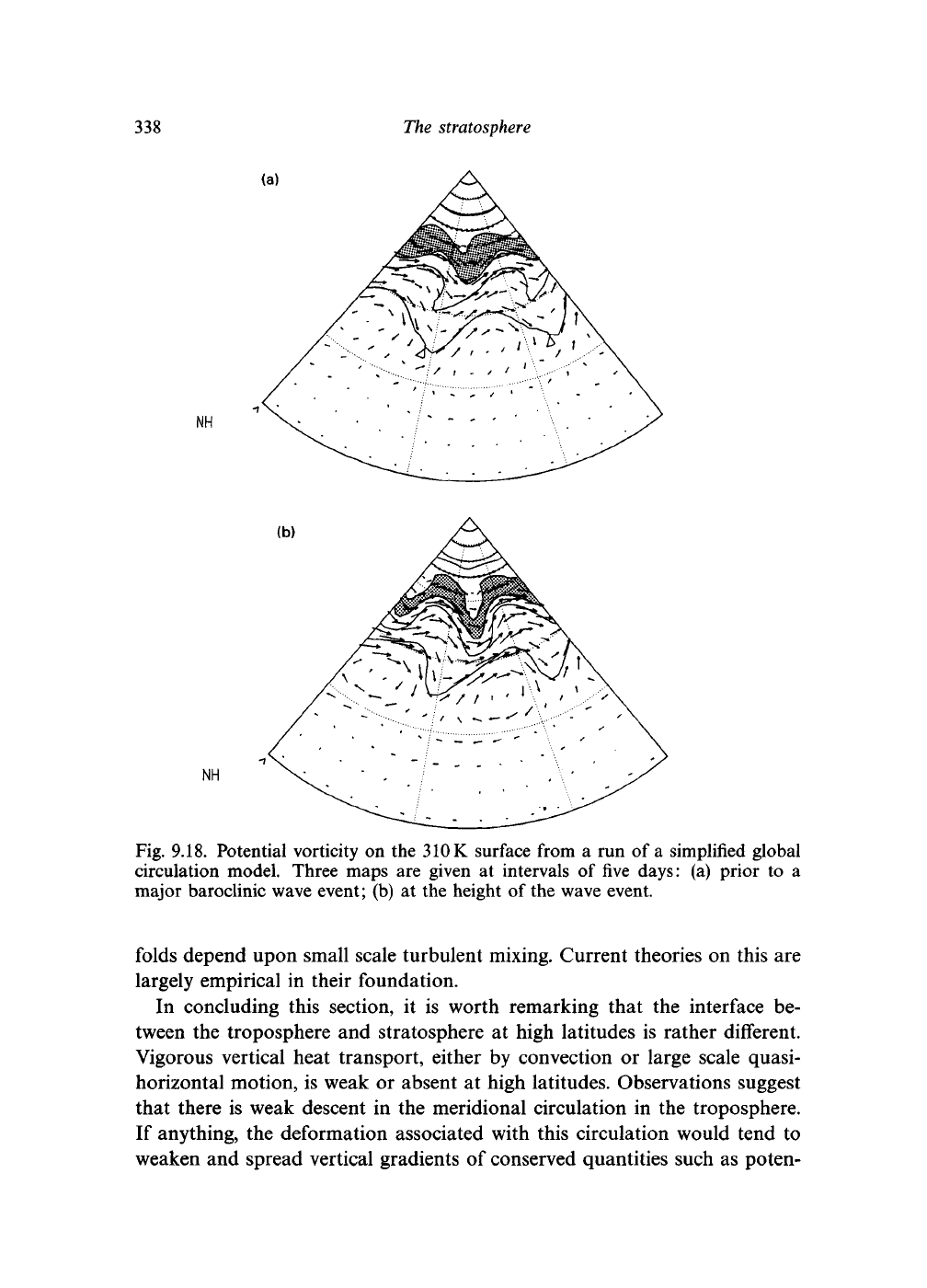
338
The stratosphere
(a)
NH
(b)
NH
Fig. 9.18. Potential vorticity on the
310
K surface from a run of a simplified global
circulation model. Three maps are given at intervals of five days: (a) prior to a
major baroclinic wave event; (b) at the height of the wave event.
folds depend upon small scale turbulent mixing. Current theories on this are
largely empirical in their foundation.
In concluding this section, it is worth remarking that the interface be-
tween the troposphere and stratosphere at high latitudes is rather different.
Vigorous vertical heat transport, either by convection or large scale quasi-
horizontal motion, is weak or absent at high latitudes. Observations suggest
that there is weak descent in the meridional circulation in the troposphere.
If anything, the deformation associated with this circulation would tend to
weaken and spread vertical gradients of conserved quantities such as poten-
